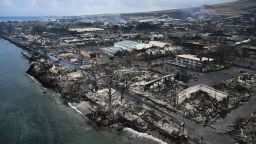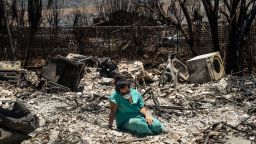The Federal Emergency Management Agency’s disaster fund is already running out of money in a year that’s setting records for billion-dollar weather disasters – all before the peak of Atlantic hurricane season has even arrived.
The relief fund is expected to be depleted by the middle or end of August, FEMA chief Deanne Criswell has warned. And now there’s growing concern inside the agency the funding could lapse if Congress doesn’t pass a spending bill, a FEMA official told CNN.
It’s been a record-breaking year for expensive disasters, including flooding atmospheric rivers in California and a deadly tornado outbreak. The federal government has tallied 15 weather-related disasters that have each exceeded $1 billion in damages – a new record for the first seven months of the year, according to data from the National Oceanic and Atmospheric Administration.
The list doesn’t yet include two of this summer’s deadliest tragedies: catastrophic flooding in New England in July, and the historic Maui wildfires, the latter of which could cost $6 billion alone, according to Hawaii Gov. Josh Green.
On Wednesday, Criswell told White House reporters FEMA has enough money for its initial response to Maui. But if Congress does not pass a $12 billion supplemental funding bill for natural disasters, it could delay recovery into next year, she said.
Criswell added that FEMA “may potentially need more” than $12 billion and is “assessing that now.”
One thing is clear: increasingly year-round disasters fueled by the climate crisis are straining the agency’s resources.
“FEMA’s losing money,” said Stephen Strader, a Villanova University professor who studies climate and natural disasters. “We’re not even in (peak) hurricane season yet and they’re projected to be in a deficit. That signals to me everything is out of whack.”
‘So much of what we do is pre-disaster’
Passing more disaster funds for FEMA will be at the top of Congress’s to-do list when it returns from recess after Labor Day. Senate Majority Leader Chuck Schumer told reporters Tuesday he wants to get it “done as quickly as possible.”
But hurdles are looming. Some conservative House Republicans have signaled they’re opposed to the overall funding request because of the additional money it contains for Ukraine. FEMA has enough money to deliver an initial response to Maui, Criswell said. Less certain is funding to help long-term recovery in Hawaii or future preparations if the spending fight on Capitol Hill becomes protracted.
FEMA’s disaster relief fund is often used to prepare for future disasters, a FEMA official told CNN. If funds dwindle before hurricane season ramps up, for example, the agency will prioritize funding for important ongoing disaster operations like Maui, while setting aside additional money to respond and initiate recovery efforts for future storms.
“If the money is there, we can send people, places and things to disasters prior to,” the official said. “So much of what we do is prep. So much of what we do is pre-disaster.” Without those funds, the official said, FEMA would likely have to wait for President Joe Biden to issue a disaster declaration to mobilize resources, a process that can take days.
Even as the agency assists in helping victims of the Maui fires and setting up temporary housing, Hurricane Hilary could bring significant flooding to Southern California.
“These things are getting bigger. We’re busier,” the official said, referring to worsening future disasters. “It’s going to continue to be more of a response.”
A lapse in funds could also impede the longer-term recovery process. Recovery could be particularly challenging for Maui for two reasons: wildfires are more costly because of how totally destructive they are, and the island is far from the mainland.
“Wildfire devastation is the hardest (disaster), it just wipes out every bit of the infrastructure,” former FEMA administrator Brock Long told CNN. “How do we rebuild the infrastructure in a more mitigated fashion, to not only handle future wildfires, but also hurricanes and everything else that is thrown at those islands? Because you can’t rebuild homes, you can’t bring businesses back online without the basic infrastructure in place.”
An increase in billion-dollar disasters
Responding to natural disasters has taken a staggering financial and human toll in the last several years. Since 2016, 139 separate billion-dollar disasters have killed at least 5,200 people and cost $1.1 trillion in damage across the United States, Adam Smith, a NOAA climatologist who tracks these events, told CNN.
Last year, 18 natural disasters cost $165 billion – the bulk of which was damage from Hurricane Ian. The year before, 20 events, including the Texas deep freeze and historic Northwest heat wave, totaled $145 billion.
Though it’s too early to determine what the total will be this year, there is a “reasonable possibility” 2023 could end up on par with the record set in 2020, which had 22 billion-dollar disasters, Smith said.
“Historically, the US experiences the highest frequency and diversity of billion-dollar disaster events – more than any other country,” Smith said.
It’s a perfect storm. The US is a large country with many hazards, “trillions of dollars of assets in harm’s way,” and a changing climate that is “amplifying the frequency and intensity of some of these extremes,” Smith said.
Smith and Strader said the US needs to focus on rebuilding stronger buildings in areas that are not as prone to extreme weather or other hazards.
“If we have not learned from the past, we are not ready for the future,” Smith said.
Lauren Fox and Morgan Rimmer contributed to this report.








